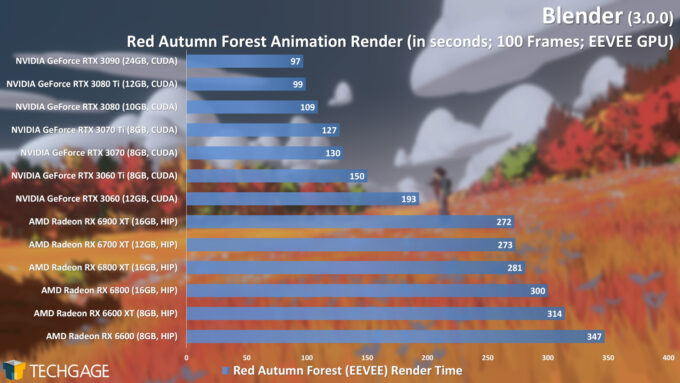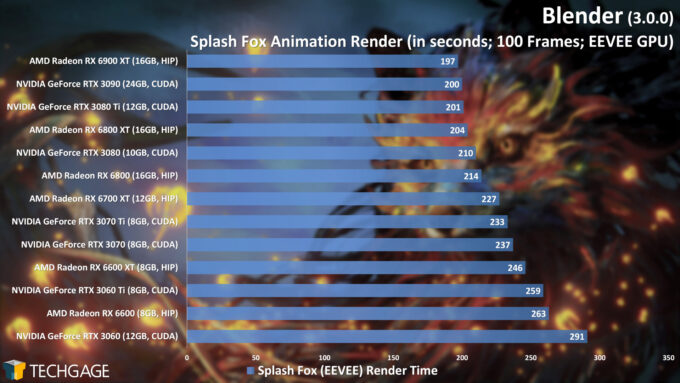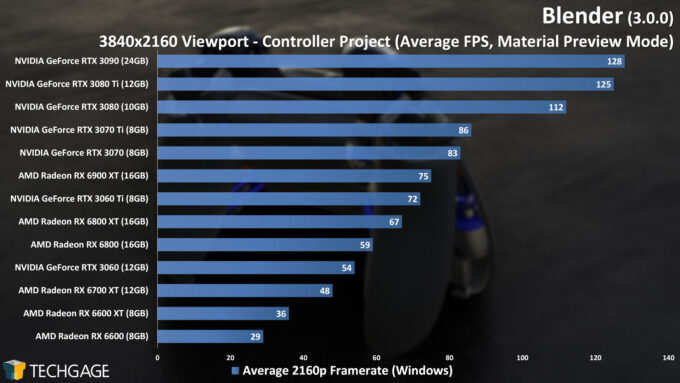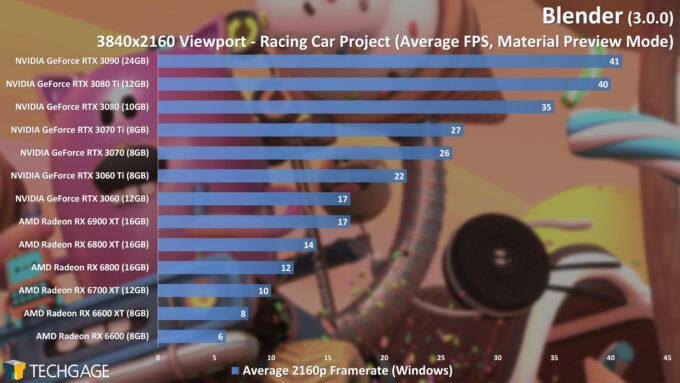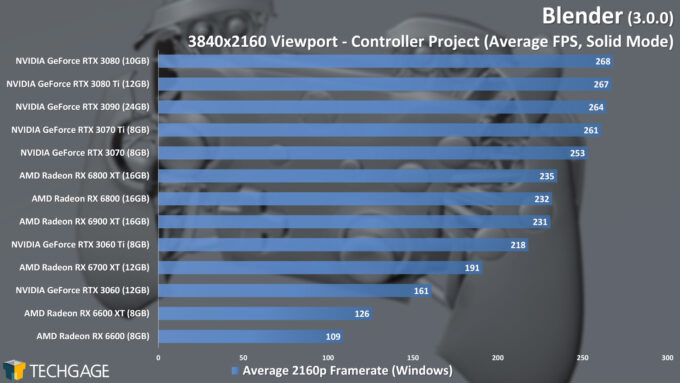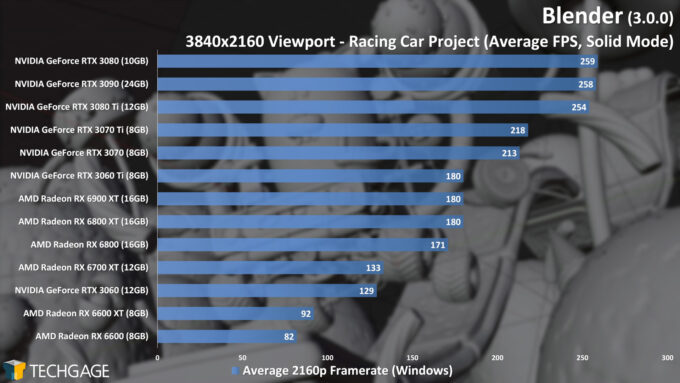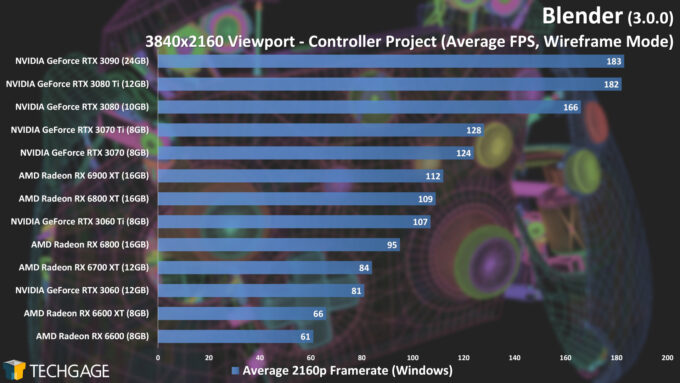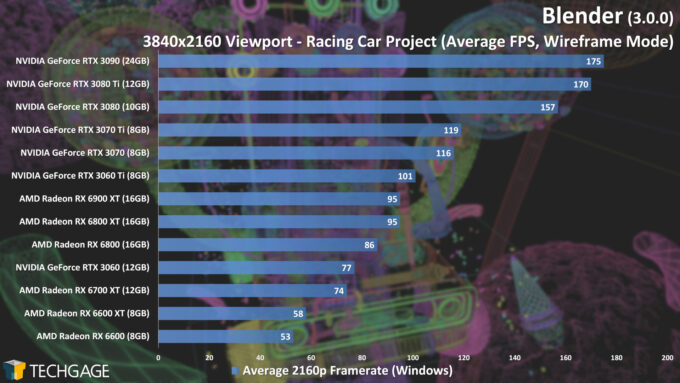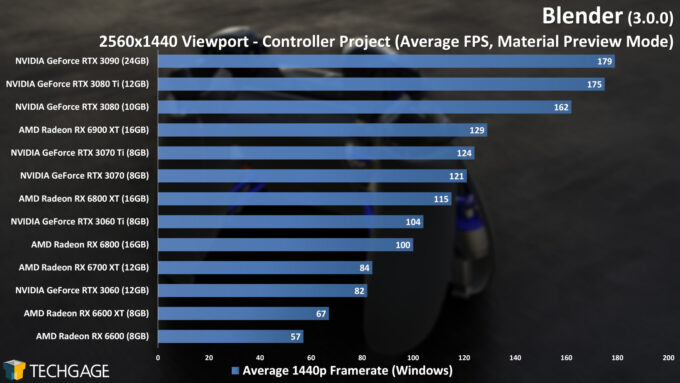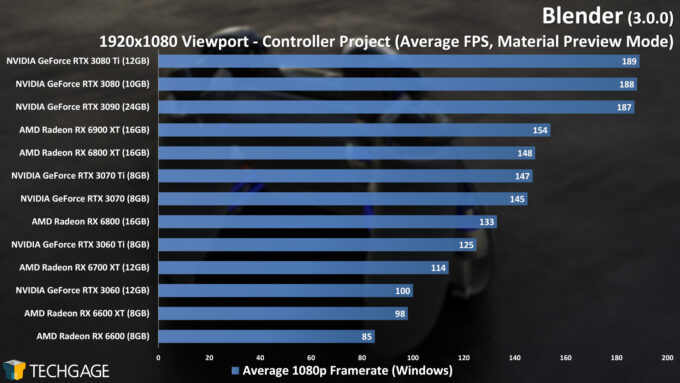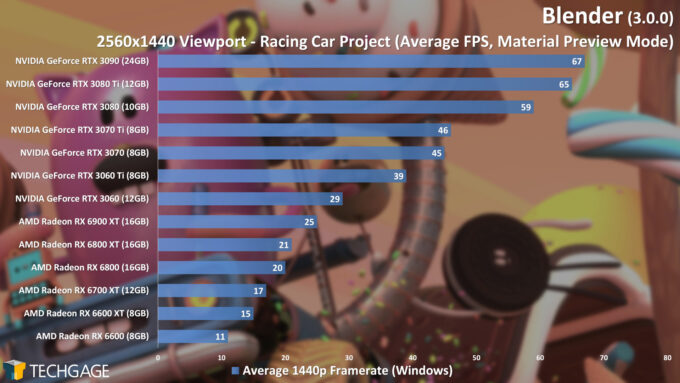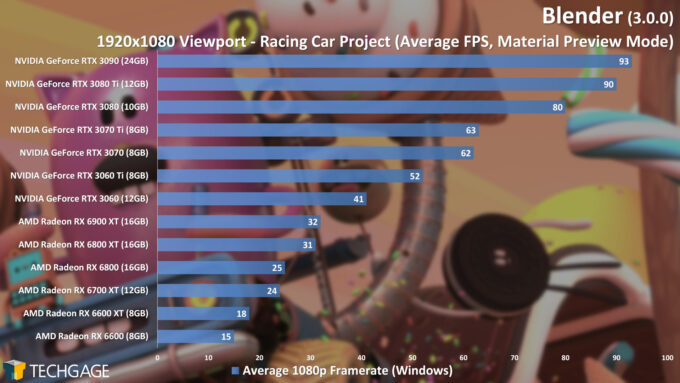- Qualcomm Launches Snapdragon 4 Gen 2 Mobile Platform
- AMD Launches Ryzen PRO 7000 Series Mobile & Desktop Platform
- Intel Launches Sleek Single-Slot Arc Pro A60 Workstation Graphics Card
- NVIDIA Announces Latest Ada Lovelace Additions: GeForce RTX 4060 Ti & RTX 4060
- Maxon Redshift With AMD Radeon GPU Rendering Support Now Available
Blender 3.0 – How Fast Are GPUs in Cycles X, EEVEE & Viewport?
Blender has just released its latest major update, pushing the software to new 3.0 versioning. As always, we’ve dug into the latest update to take a look at it from a performance perspective. Join us as we throw all of the current-gen GPUs from GeForce and Radeon at Cycles X, EEVEE, and the viewport.
Page 2 – Blender 3.0: EEVEE Rendering & Viewport Performance
EEVEE GPU: AMD & NVIDIA Rendering
In the last batch of Blender performance deep-dives we’ve done, we’ve tested EEVEE using the Mr. Elephant project (found on the Blender demo files page), cranked its sample count, and then rendered a single frame. We’ve since realized that this is not the best way to go about EEVEE testing, as most people will use the engine for animations – and no one realistically uses sky-high sample counts like we did.
Before swapping out Mr. Elephant for some animations, we gave the project a test anyway between 2.93 and 3.0, to see if any performance differences could be seen. Interestingly enough, 3.0 gave us a notably worse result than 2.93, but nothing too severe. After testing a few animation projects between versions, and seeing no difference, we came to the conclusion that whatever performance degradation we saw was not one most people would – since we were using a sky-high sample count, which just isn’t realistic for EEVEE.
Nonetheless, we’ve now moved onto two new animation projects, both of which can be found at the same demos link above. Of the two, Red Autumn Forest is the more GPU hungry, as it’s not as reliant on the CPU through its render. Splash Fox is different, in that it takes larger breaks in between each frame render to take care of compositing tasks.
Let’s see how these projects compare in our testing:
These results are far more interesting than the ones we used to see with Mr. Elephant, especially since they’re both different in design. As mentioned above, Red Autumn Forest uses the GPU more throughout its render process than Splash Fox does.
In a test with an RTX 3080, we found that Red Autumn Forest used the GPU 70% of the time through the process, whereas Splash Fox dropped to 40% average usage. The fact that the CPU is involved a lot more in the Splash Fox render is made obvious with the tighter scaling between all of the models.
While NVIDIA won the EEVEE battle against AMD with Mr. Elephant, the gains in Red Autumn Forest are much more pronounced – there’s a clear separation between the vendors. But, in the more complex Splash Fox project, AMD’s Radeons perform great overall, straight from the bottom to the top. This is the most refreshing AMD Blender result we’ve had in a while, so cherish it!
To wrap-up our performance testing, we’re going to set aside rendering to test out the performance in Blender’s viewport:
Viewport: Material Preview, Solid & Wireframe
We mentioned in the “What’s New?” section of the last page that Blender’s viewport has seen some performance improvement in 3.0, but that’s largely related to using the rendering mode, which is both difficult to measure for benchmarking purposes, and made a little redundant with our numerous actual rendering tests.
When we gave 2.93 performance a quick retest with up-to-date drivers, we didn’t see any notable improvements or differences, but we retested everything anyway for the sake of having the most up-to-date numbers. Most didn’t change too much, but some did. Since we published our Blender 2.93 performance look, AMD released two new GPUs: Radeon RX 6600 XT and RX 6600, so the inclusion of those is the most notable change here.
Let’s start with a look at the Material Preview (LookDev) performance at 4K:
For simpler projects like the Controller one used here, any one of these listed GPUs is going to deliver good enough performance for working with, but naturally, your camera panning will become much smoother with a higher-end GPU. The Racing Car project is the more complex of the two, which is made evident with the results being at least a third of those that we saw with the Controller project. If you’re working with really complex projects in Material Preview mode, you’ll definitely want a higher-end GPU.
Overall, there’s quite a large performance delta seen between the bottom and top GPUs in both results here, making it a great benchmark.
With Solid and Wireframe, the GPU is relied upon less, and the CPU is relied upon more. That results in performance that’s far different from Material Preview, as you’ll see below:
Even with the Solid mode being a lot easier on the GPU than the Material Preview mode, there’s still a large difference seen across the stack, but every single one of our tested GPUs can deliver great performance here. If you like smoothness, and have a high refresh monitor, the fastest GPUs here will take good advantage of it.
Let’s take a look at Wireframe mode next:
Wireframe mode’s complexity results in a reduced frame rate when compared to the Solid mode, but overall, the performance is still great across-the-board. The entire stack tested here hits 60 FPS, or at least comes really close, which is competent enough. Still, the faster your GPU, the more you will be able to take better advantage of your high-refresh monitor.
Naturally, as you reduce the viewport resolution, the performance will increase. Not everyone runs 4K, so here are 1440p and 1080p benchmarks using the Material Preview mode:
If we had to choose one GPU from the entire lot that could be the best bang-for-the-buck when working in the viewport, it’d be the GeForce RTX 3070. If you compare it to the next step down in most of the viewport results, it has one of the most notable leaps ahead, and ultimately, delivers great performance, even at 4K.
Wrapping Up
With Blender 3.0 bringing so much to the table, it’s a release we were quite excited about jumping on to performance test. While the introduction of Cycles X is one of the biggest highlights for us, there’s a lot to love. If you don’t regularly check out the latest release notes, there are likely a bunch of minor improvements made under-the-hood that you may not have even noticed.
As we saw in our Cycles testing, the overhauled engine has done a lot of good, with performance improvements being seen across all of the APIs we tested with. CUDA in 3.0 performed as well as OptiX in 2.93 in some cases, while OptiX itself sees its performance propelled further ahead in 3.0.
As covered earlier, while we didn’t test CPU rendering here, we did do some light testing and saw slight improvements in our tested projects. Overall, the gains are not as notable as they are with GPU rendering, but they are appreciated nonetheless – and will especially be appreciated by those who don’t have an OptiX-capable GPU, and are using heterogeneous rendering instead.
We do plan to look deeper into CPU performance in Blender at some point soon, not likely just with rendering, but other tasks, as well. If you have suggestions of areas we should look, please leave us a comment below.
While we didn’t see much of a performance impact in Blender 3.0 on EEVEE rendering or viewport performance, the next year should spice those angles up a bit. As it stands, Blender plans to transfer both EEVEE and viewport to revolve around Vulkan, and when that happens, the performance results we see in our charts will undoubtedly be shaken up a bit – we’re just not sure in which way, yet!
Support our efforts! With ad revenue at an all-time low for written websites, we're relying more than ever on reader support to help us continue putting so much effort into this type of content. You can support us by becoming a Patron, or by using our Amazon shopping affiliate links listed through our articles. Thanks for your support!




